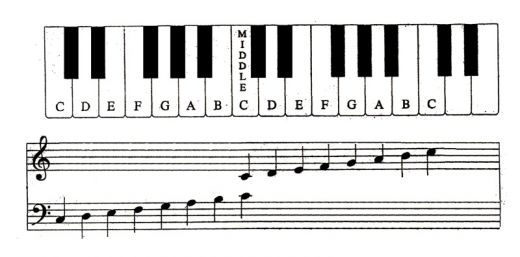
It is a very simple question but one that many people don't know the answer to: what is the difference between the major and minor scales? Well, it is an easy answer wrapped up in complicated language. First we have to understand that we're talking about a group of tones to which we have assigned the name "scale".. In this example we'll use the C Major scale tones: C, D, E, F, G, A, B, and C (the next octave up). There are no accidentals in the scale of C Major, it may be found easily on the piano, just the white keys, starting from any C note on the keyboard (see the picture!) and ascending to the next octave. The major scale may be sung in solfeggio: do-re-mi-fa-so-la-ti-do! Now sing it, like Julie Andrews!
Now here is the weird part. To create the C minor scale we have to make a few adjustments to the original Major scale. Those adjustments are as follows: We'll take the third scale degree, "mi" and drop the tone one half-step to "me" (this creates a minor third relationship between our 1 "do" and our 3rd "me"). Then we'll flat the 7th tone as well, from "ti" to "te". That's it, now we have do-re-me-fa-so-la-te-do! Our C natural minor scale! Now take a look at the picture above this paragraph. Can you see that if we were to play the C Major Scale, but started on the tone of A and played through to another A we would be playing the A Minor scale! Why is this? Well, they share the same key signature and tones!
Now wasn't all that easy to figure out? It wasn't? Well then, perhaps Matt Burk Music Studio can help shed some light on the theory behind musical ideas that many hold commonplace but aren't exactly sure how or why they work. We can incorporate this into fun, digestible, goal-oriented lessons on the instrument you choose! We offer private music lessons in piano, guitar, drums, bass, voice, songwriting, and audio production. Matt Burk Music Studio: Learn, Create, Perform!

